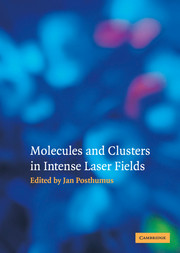Book contents
- Frontmatter
- Contents
- Preface
- 1 Ultra-high-intensity lasers based on Ti: sapphire
- 2 Diatomic molecules in intense laser fields
- 3 Small polyatomic molecules in intense laser fields
- 4 Coherent control in intense laser fields
- 5 Experimental studies of laser-heated rare-gas clusters
- 6 Single-cluster explosions and high-harmonic generation in clusters
- 7 Interactions of intense laser beams with extended cluster media
- Index
1 - Ultra-high-intensity lasers based on Ti: sapphire
Published online by Cambridge University Press: 29 March 2010
- Frontmatter
- Contents
- Preface
- 1 Ultra-high-intensity lasers based on Ti: sapphire
- 2 Diatomic molecules in intense laser fields
- 3 Small polyatomic molecules in intense laser fields
- 4 Coherent control in intense laser fields
- 5 Experimental studies of laser-heated rare-gas clusters
- 6 Single-cluster explosions and high-harmonic generation in clusters
- 7 Interactions of intense laser beams with extended cluster media
- Index
Summary
Introduction
Naturally, the scientific study of matter under extreme conditions is of fundamental interest, but it is also true that its direction and progress are largely determined by technological innovations. Also theorists generally stay within the bounds of what is (nearly) feasible, for even the best theories require verification. The technological development underlying the subject of this book is that of high-power lasers. Particularly the advent of affordable, ultra-short-pulsed lasers has considerably intensified the study of molecules and clusters in intense fields.
Two determining technical advances in this respect were the development of chirped pulse amplification (CPA) and the self-mode-locked Ti: sapphire laser (which has generated pulses as short as 7 fs). It is thus possible to build laboratory-scale systems that produce high-energy pulses (3–4 mJ in 20 fs), even at kilohertz repetition rates. An even more powerful system, a 100-TW, sub-20-fs laser system was demonstrated by Yamakawa et al., but at the lower repetition rate of 10 Hz. Extremely short pulses of only 4.5 fs – but still with energies as high as 70 μJ – were achieved with pulse compression techniques by Nisoli et al.
Particularly energetic laser pulses are required for the study of inertial-confinement fusion (ICF). At the Lawrence Livermore National Laboratory, for example, 660 J in a 440 ± 20-fs pulse can be focused down to an intensity > 7 × 1020 W cm−2.
- Type
- Chapter
- Information
- Molecules and Clusters in Intense Laser Fields , pp. 1 - 26Publisher: Cambridge University PressPrint publication year: 2001



